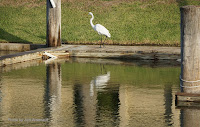GREAT EGRET
GREAT EGRET (Ardea alba) – (See images below)
DESCRIPTION: The Great Egret is completely white, with a yellow-orange bill and long, black legs. The bird has long, slender feathers extending from the back, called ‘aigrettes’ (hence the bird’s name). Sexes are similar. The great egret is almost as large as the Great Blue Heron, at around one meter (40 inches) long.
VOICE: https://www.xeno-canto.org/species/Ardea-alba
NAME: The great egret is also called ‘white heron’ (the Latin species name ‘Alba’ means ‘white’), not to be confused with the white morph of the great blue heron. The English name ‘Egret’ comes from French ‘aigrette’, which refers to the feathers of that bird that were used as ornaments. The Latin genus name ‘Ardea’ means ‘heron’.
HABITAT: The great egret lives on marshland, and feeds in either fresh or brackish water.
DIET: Mainly fish. Great egrets stand immobile in shallow water, then spear their prey with their powerful bill. They also feed on small reptiles or birds, insects or invertebrates.
NESTING: They nest in colonies on top of mature trees, just like the Great blue heron. The nest is made of sticks and lined with plant material. Usually new nests are built each year. Around four light blue eggs are laid, which are incubated by both parents. The chicks are also fed by both parents.
DISTRIBUTION: The Great egrets are found around the world, breeding in parts of eastern USA, eastern Europe and mid-Asia. Some groups are year-round residents south of the breeding range, while others migrate to either Mexico, Central or South America, and to Africa. Some vagrants have been able to reach Hawaii. (See note below for information on bird vagrancy.)
DISTRIBUTION MAP: https://en.wikipedia.org/wiki/Great_egret#/media/File:Ardea_alba_map.svg
ON PEI: The great egret is rare on Prince Edward Island. This means only up to five individuals are observed per summer season, and there’s no record of breeding activity.
CONSERVATION: The beauty of great egrets almost doomed the species, as they were hunted for their white feathers as fashion ornaments. The species is currently not considered at risk.
NOTES: The great egret belongs to the heron family. As is typical for other herons, when flying it will fold back its neck. The great egret is the symbol of the National Audubon Society. This makes sense since this conservation organization was founded to protect the birds from feather hunters.
Vagrancy: In biology this means an animal going way outside its normal range. For birds, this can happen when there are storms and they get blown off course. On other times, the bird simply wanders in a different direction than usual. Here’s an article about vagrancy in birds.
SIMILAR SPECIES: Snowy Egret, Great Blue Heron (white morph), Little Blue Heron (juvenile)
REFERENCES: https://en.wikipedia.org/wiki/Great_egret
http://www.nhptv.org/natureworks/greategret.htm
http://www.oiseaux-birds.com/card-great-egret.html
https://www.allaboutbirds.org/guide/great_egret/id
https://www.audubon.org/field-guide/bird/great-egret
https://www.nps.gov/ever/learn/nature/greategret.htm
https://identify.whatbird.com/obj/30/_/Great_Egret.aspx
DESCRIPTION: The Great Egret is completely white, with a yellow-orange bill and long, black legs. The bird has long, slender feathers extending from the back, called ‘aigrettes’ (hence the bird’s name). Sexes are similar. The great egret is almost as large as the Great Blue Heron, at around one meter (40 inches) long.
VOICE: https://www.xeno-canto.org/species/Ardea-alba
NAME: The great egret is also called ‘white heron’ (the Latin species name ‘Alba’ means ‘white’), not to be confused with the white morph of the great blue heron. The English name ‘Egret’ comes from French ‘aigrette’, which refers to the feathers of that bird that were used as ornaments. The Latin genus name ‘Ardea’ means ‘heron’.
HABITAT: The great egret lives on marshland, and feeds in either fresh or brackish water.
DIET: Mainly fish. Great egrets stand immobile in shallow water, then spear their prey with their powerful bill. They also feed on small reptiles or birds, insects or invertebrates.
NESTING: They nest in colonies on top of mature trees, just like the Great blue heron. The nest is made of sticks and lined with plant material. Usually new nests are built each year. Around four light blue eggs are laid, which are incubated by both parents. The chicks are also fed by both parents.
DISTRIBUTION: The Great egrets are found around the world, breeding in parts of eastern USA, eastern Europe and mid-Asia. Some groups are year-round residents south of the breeding range, while others migrate to either Mexico, Central or South America, and to Africa. Some vagrants have been able to reach Hawaii. (See note below for information on bird vagrancy.)
DISTRIBUTION MAP: https://en.wikipedia.org/wiki/Great_egret#/media/File:Ardea_alba_map.svg
ON PEI: The great egret is rare on Prince Edward Island. This means only up to five individuals are observed per summer season, and there’s no record of breeding activity.
CONSERVATION: The beauty of great egrets almost doomed the species, as they were hunted for their white feathers as fashion ornaments. The species is currently not considered at risk.
NOTES: The great egret belongs to the heron family. As is typical for other herons, when flying it will fold back its neck. The great egret is the symbol of the National Audubon Society. This makes sense since this conservation organization was founded to protect the birds from feather hunters.
Vagrancy: In biology this means an animal going way outside its normal range. For birds, this can happen when there are storms and they get blown off course. On other times, the bird simply wanders in a different direction than usual. Here’s an article about vagrancy in birds.
SIMILAR SPECIES: Snowy Egret, Great Blue Heron (white morph), Little Blue Heron (juvenile)
REFERENCES: https://en.wikipedia.org/wiki/Great_egret
http://www.nhptv.org/natureworks/greategret.htm
http://www.oiseaux-birds.com/card-great-egret.html
https://www.allaboutbirds.org/guide/great_egret/id
https://www.audubon.org/field-guide/bird/great-egret
https://www.nps.gov/ever/learn/nature/greategret.htm
https://identify.whatbird.com/obj/30/_/Great_Egret.aspx
 |
| Great egret, Stratford, CT, Denise Motard |
 |
| Great egret in flight North Rustico, PEI, Canada - by Matt Beardsley |
 |
| Great egret on alert, Amelia Island Greenway, FL - by Roberta Palmer |
 |
| Great egret, Aransas Bay, TX, by Jodi Arsenault, Feb. 19, 2017 |
 |
| Great egret, breeding plumage Jekyll Island, GA, Roberta Palmer |